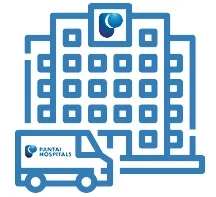Oesophageal cancer occurs when a malignant tumour forms in the oesophagus lining. It begins in the inner layers and can eventually spread through the other layers, affecting the deep tissues and muscles of the oesophagus.
The oesophagus is a hollow and muscular tube that is located in the centre of the chest and is part of the digestive system. It connects the throat to the stomach and is responsible for transporting food and liquid from the mouth to the stomach.
When a person swallows food or liquid, the walls of the oesophagus contract to propel the contents down into the stomach. This is done with the help of the upper oesophageal sphincter muscle.
Food or liquid then passes through the lumen, the oesophagus lining, and eventually reaches the gastroesophageal junction, where it then goes into the stomach.
What are the types of oesophageal cancer?
The type of cells involved is the primary basis of classifying the type of oesophageal cancer an individual is diagnosed with.
The two main types are adenocarcinoma and squamous cell carcinoma. Identifying the type of cancer is crucial for doctors to direct the best form of treatment.
- Adenocarcinoma: This form of oesophageal cancer begins in the mucus-producing epithelial cells in the oesophagus. It tends to present itself in the lower section of the oesophagus near the stomach.
- Squamous cell carcinoma: This form begins in squamous cells, which exist in the oesophagus' inner lining. This type can occur along the entire oesophagus but usually affects the upper or middle section.
There are other rare types, including small cell carcinoma, sarcoma, lymphoma, melanoma, and choriocarcinoma, but they generally tend to make up less than 1% of oesophageal cancers.
What are the risk factors of developing oesophageal cancer?
Risk factors of oesophageal cancer include:
- Being overweight or obese
- Having a poor diet
- Being older and around the age of 60s
- Frequently smoking or consuming tobacco products
- Consuming large amounts of alcohol regularly
- Being diagnosed with gastroesophageal reflux disease (GERD)
- Having precancerous changes through Barrett’s oesophagus
- Having Human papillomavirus (HPV)
What are the signs and symptoms of oesophageal cancer?
Oesophageal cancer typically does not cause any symptoms in the early stages. It can, therefore, be hard to identify it at the onset. However, as it develops and reaches advanced stages, these symptoms will begin to appear:
- Difficulty swallowing
- Sudden weight loss
- Chest pain or a burning sensation on chest
- Indigestion that worsens over time
- Heartburn
- Hoarseness
- Chronic coughing
- Vomiting
However, having a few of these symptoms does not necessarily point to a diagnosis of oesophageal cancer. This is because some of these symptoms listed above can be linked or caused by other conditions.
That said, it is crucial to get a diagnosis from a doctor to rule out the presence of malignancy.
How do doctors diagnose oesophageal cancer?
Other than reviewing the individual's medical history and physical examination, the following are some diagnostic tools used by doctors:
- Barium swallow study: It involves ingesting liquid barium to cover the inside of the oesophagus prior to an x-ray evaluation of the oesophageal tissue.
- Endoscopy: The procedure involves inserting a flexible tube with a camera lens down the throat and into the oesophagus to inspect the oesophagus and look for cancer or inflammation.
- Biopsy: It involves taking a sample of suspicious tissue to be examined for the presence of cancer cells.
Tests to check if cancer has spread to other areas of the body include:
- Bronchoscopy
- Endoscopic ultrasound
- Computerised tomography (CT)
- Magnetic resonance imaging (MRI)
- Positron emission tomography (PET)
Learn more about the different types of screening and diagnostic procedures performed to diagnose oesophageal cancer.

How is oesophageal cancer treated?
The best course of treatment is determined by the stage and type of cancer as well as the patient’s overall health. It also depends on whether the entire tumour can be surgically removed.
The following are the standard treatment possibilities for oesophageal cancer:
- Surgery is the most commonly used treatment.
- Oesophagectomy: The doctor will remove the cancerous portion of the oesophagus, the upper part of the stomach, and the lymph nodes nearby. The oesophagus is then connected to the remaining part of the oesophagus.
- Oesophagogastrectomy: This surgical method removes the affected part of the oesophagus, nearby lymph nodes, and a bigger portion of the stomach.
- Endoscopic submucosal dissection (EDS) or endoscopic mucosal resection (EMR) is a procedure to remove tumours endoscopically if the tumour is very small and confined to a tiny section.
- Chemotherapy utilises powerful drugs such as cisplatin, carboplatin, paclitaxel, and oxaliplatin to kill cancer cells or prevent them from dividing.
- Radiation therapy employs radiation doses to kill cancer cells or limit their growth.
- Electrocoagulation uses electrical current to kill cancer cells.
- Targeted therapy are treatments that target specific areas to reduce cancer growth, such as HER2-targeted therapy and anti-angiogenesis therapy.
- Immunotherapy enhances, directs, or restores the natural defence mechanisms of the body against cancer.
- Photodynamic therapy (PDT) uses photoactive drugs that are injected into the cancerous cells to destroy them.
Learn more about the different types of treatment technologies to treat oesophageal cancer.
What can I do to reduce the risk of developing oesophageal cancer?
Here are some lifestyle changes that individuals can adopt to limit their risk of developing the disease:
- Refraining from frequent tobacco use.
- Refraining from frequent alcohol use
- Maintaining a healthy body weight.
- Consuming a healthy diet rich in vitamins and nutrients with lots of fruits and vegetables.
- Engaging in physical activity often.
- Get treatment if you have acid reflux or Barrett’s oesophagus.
Oesophageal cancer is a serious medical condition that may have variable prognosis. It is, therefore, important to check on symptoms and warning signs for early detection. Additionally, maintaining a healthy lifestyle and getting regular health check-ups is recommended.
Do I need to get screened for oesophageal cancer?
There is currently no available routine screening test for individuals at average risk of developing oesophageal cancer. However, close follow-ups are advised for certain individuals who are at high risk of developing oesophageal cancer. Consult with your doctor if you have any of the following conditions to arrange a monitoring plan for early oesophageal cancer detection.
Make an appointment at Pantai Hospitals
Early detection of oesophageal cancer makes it easier to treat the disease with effective and appropriate treatment. A dedicated multidisciplinary team of specialists and oncologists at Pantai Hospitals is available for consultation to provide the best care and assistance to patients through screening, diagnosis, and treatment.
Get in touch with us to book an appointment today if you have any concerns or questions about oesophageal cancer treatment options.
Pantai Hospitals have been accredited by the Malaysian Society for Quality in Health (MSQH) for its commitment to patient safety and service quality.


 Request an Appointment
Request an Appointment.webp?sfvrsn=276ce14_1/vector-(3).webp) International Patient
International Patient

.webp)


 Find A Doctor
Find A Doctor


.png?sfvrsn=71934c60_8)
.png?sfvrsn=1370dfbd_9)






